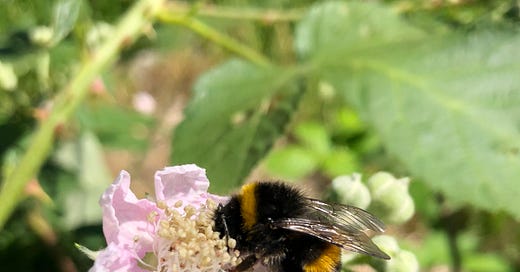Thing 1 – Bees
“According to all known laws of aviation, there is no way that a bee should be able to fly. Its wings are too small to get its fat little body off the ground. The bee, of course, flies anyway. Because bees don't care what humans think is impossible.”
If you were either a child of film-watching age in 2007, or a parent of said child, you’ll have heard that quote, from the beginning of Dreamworks’ Bee Movie – possibly multiple times. And it was certainly a saying I remember from my childhood. One of those myths, in the same class as “You’re never closer to death than when you sneeze” and “Bob Holness played the saxophone solo on ‘Baker Street’” (although that one must have come later, because Blockbusters wasn’t a thing when I was a child.)
All of them, of course, are a load of nonsense. But while death-sneezing and Holness have been debunked, I’d be willing to bet that there are still grown adults out there convinced that bees are somehow doing something impossible right there in front of us, and yet they just shrug their shoulders and accept it.
As far as I can tell, the first documentary evidence of the claim came from a 1934 book by Antoine Magnan called Le Vol des Insectes:
“Inspired by what is done in aviation, I applied the laws of air resistance to insects, and, with my assistant André Sainte-Laguë, reached the conclusion that their flight is impossible.”
The mistake Magnan made was to assume that bees (and all insects, come to that) flap their wings straight up and down, as if they were animated aeroplanes. This, of course, is not the case. They flap them at an angle – down and forward – then flip them over for the upstroke and go again (230 times a second, in the case of the honey bee, which is of course a lot, but in the grand scheme of insect wingflap frequency, pales into insignificance next to the 1,000 or so beats per second achieved by tiny midges known, appropriately enough, as ‘No-See-Ums’.)
Sorry, just going to dwell on that. One thousand beats. Every. Second.
OK. On we go.
Rather than the smooth flow of air experienced by an aeroplane wing, the wings of insects and small birds have tiny tornado-like airflows that form on the leading edge. One of these is known as a Leading Edge Vortex, or LEV for short (gosh, how kind, what can I say? I’m truly honoured.)
It used to be thought that these LEVs had the superpower of providing all the extra lift an insect needs to keep it in the air (LEVs are often small but mighty), but the prevailing view nowadays (backed up by science and everything) is that the presence of these vortices enables the insects to increase the angle of attack of their wing strokes without suffering the phenomenon known as ‘stall’.
You know about stall, even if you think you don’t, if you’ve ever held your hand out of the window of a moving car. It isn’t the same thing as the stalling of an engine, although it does have a similar effect. When the angle of attack (which is to say, the angle between the object and the oncoming wind) reaches a certain point – between 15 and 50 degrees, depending on the size and shape of the object in question – lift is suddenly and drastically reduced. One second your hand has a nice smooth flow of air travelling over it, but tilt it a little bit into the wind and you’ll find it’s suddenly being buffeted by the localised equivalent of a hurricane. The sensation this produces, incidentally, I have always found one of the great innocent delights of life.
So anyway: BEES.
Bees are great. That’s all I’m prepared to say at this time.
There’s a more detailed version of this in Taking Flight, which (as I will, I’m afraid, never weary of mentioning, is out on May 4th and you can pre-order here).
Thing 2 – Chalk of Champions
Last week I got all wibbly about pencils. This week it’s the turn of chalk. Yes, I know. This level of obsession with writing implements is probably not healthy. I am, however, unrepentant.
Thing 3 – The Auction Game
I am bad at this game. (Don’t click the picture – click the previous sentence!)
Thing 4 – Plots
Normally at this point, when wanting to share something from Twitter, I’d post a link and the tweet would appear and you’d be able to read it and if you liked it you could click on it and go to the tweet and maybe follow the person who tweeted it – if, that is, Twitter is your thing, and I know for many people it never has been, and increasingly people are going off it, with – let’s be honest – good reason, because NOW (as of yesterday) if I want to share a tweet here, I can’t. Not in the old, user-friendly way, at least.
If you’re at all interested in why this is happening, James Ball has written clearly about it here.
It’s all so tedious and childish, is my point of view.
ANYWAY.
This lovely thing was written by Imogen West-Knights, who you can find here. She introduced it thus: “my little while ago friend and i made a list of all possible novel plots and it has kind of ruined reading for me.”
Thing 5 – Combat juggling
Just when you think there are enough sports – perhaps, speak it soft, too many? – along comes Combat Juggling to prove you wrong. (Thanks to Daniel Holland for sharing it.)
Thing 6 – Radio Lento
After that, what you need is to slow down a bit, and Radio Lento is very much here for all your slowing down needs. A simple concept, beautifully executed. All they do is place panoramic microphones in natural places and leave them there. They then review the recordings and choose the most appropriate chunk for each episode. No talking, no music, no adverts – just wind and water and birds and insects and so on. Lovely stuff.
You can read more about their approach here.
You can follow them on Twitter here.
And you can subscribe to the podcast by going here and scrolling down a bit. Or you can just search ‘Radio Lento’ on your preferred podcast provider.
I’d do all of those things, if I were you. But that’s just me.








Love Radio Lento. In a noisy city with few birds and no running water to be heard close by, it is the most amazing thing.
Radio Lento will be my new calm!